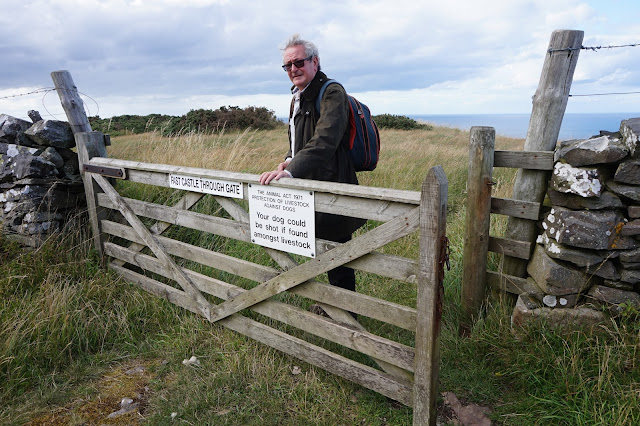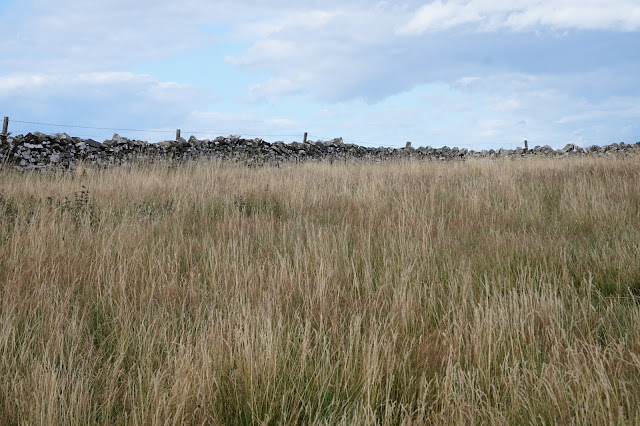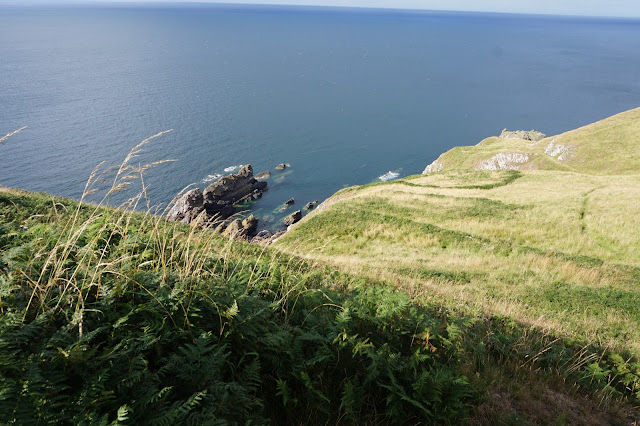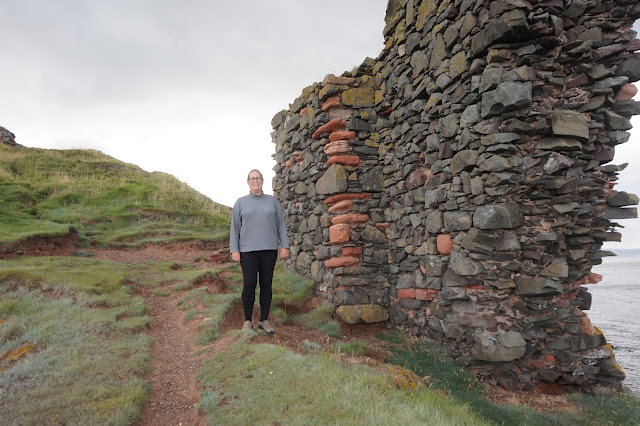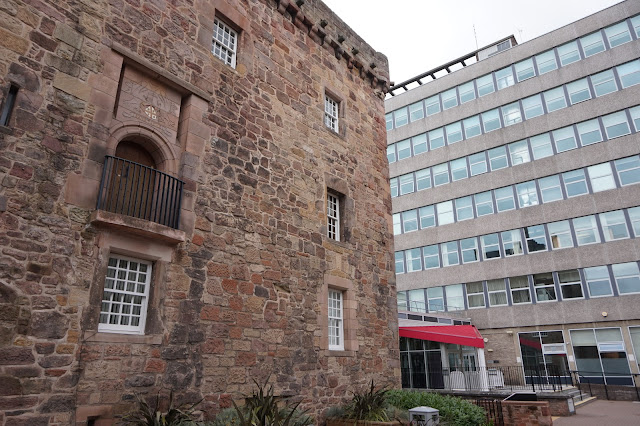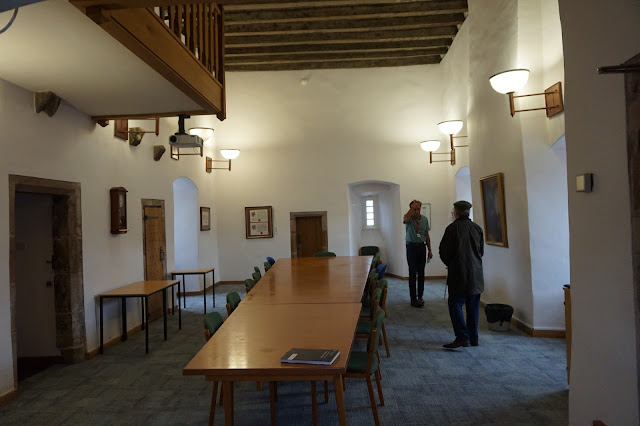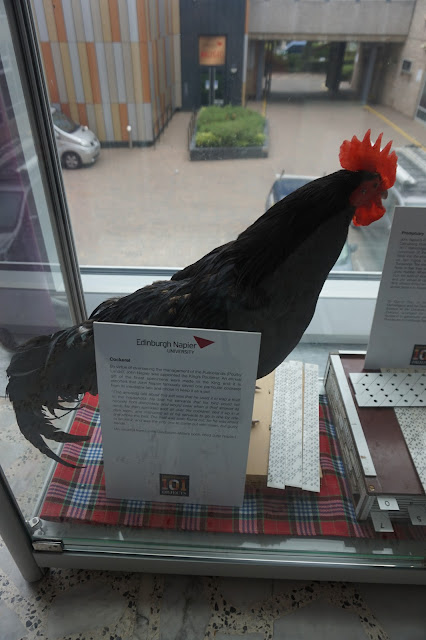My focus is very much on mathematician John Napier these days, especially since I was able to get to Scotland this summer (2021), the pandemic notwithstanding. I had tried for years to figure out how to get to Fast Castle, a very remote location, and there was just absolutely no way I could do it on my own trying to use public transportation no matter how I combined things like trains, buses, or even taxis. Because of Toby, a wonderful tour guide that I connected with I was finally able to get here! The reason I'm so interested in this spot is that it is the site of a treasure hunt undertaken by "my" mathematician, John Napier. I could write paragraphs and paragraphs about this intriguing story, but I'll just share a bit and then get on with posting pictures. Napier had a reputation as a sorcerer, which is a dangerous reputation to have had in the 16th century. People often ended up executed if they were suspected of being sorcerers. Napier was not only a scholar and an elder in his church, but he was a delegate to the General Assembly of the Presbyterian Church, the author of a major theological work, and did some advising to King James VI/I (who was particularly well known for burning "witches"). So it seems to me that he had this reputation among the locals and at least one peer, Robert Logan of Restalrig. Logan owned Fast Castle, which had (and has!) a reputation for being a location for hidden treasure - perhaps even Templar treasure. There is a contract between Logan and Napier for Napier to go to Fast Castle and use his sorcerous skills to search for treasure. There is a great deal to the story, but I'll leave it at that (for now!). I should add that the hunt may or may not actually have taken place, but the contract exists and is in Napier's own hand, and so off I went to check it out!After driving to a location that was a close as we could get to the site, we still had quite a trek across farmland and hills to get there!
I'm really thankful that the land owners allow people onto their property, mark it so well, and maintain the path!
First we walked across grassy farmland, and then the grassy landscape gave way to hillsides so full of heather that they looked like purple hills.
The heather gave way to bracken fern, and it was then that we began to see the ruins of the castle out on a promontory far downhill. This whole trek was really quite a scramble. We are quite far above the castle here, but the castle itself is on a cliff 150 feet above the water.
The bracken gave way to grassland again. I love the rocks in the sea at the base of the castle cliffs.
This is the view I have always seen of this site. It has never looked big enough to me to hold a castle.
Across the drawbridge we go, and this too was quite a scramble - even with a few little steps to help out; it was hard to get to the steps in the first place!In order to get some scale or perspective on this, I took a picture of Toby working on getting up that slab of stone in order to even get to the helpful few steps on the far end.
Even though we have already descended very far in elevation, we are still atop high cliffs.
The promontory is actually quite spacious. I'll post some pics to try to represent that, but it is hard to see because the promontory is made up of about 4 plateaus with steep drops down to each one, so they are rather hidden whether you look up or down. I have no idea how anyone built a castle here! I also can't quite imagine how large retinues traveled here. For instance, in 1503 Margaret Tudor, the sister of King Henry VIII of England, spent the night here on her way to Edinburgh to marry King James IV of Scotland. I know horses are sure-footed, but I imagine if they came overland that Princess Margaret would have been in a carriage of some sort, as would her ladies in waiting, and this is very steep terrain. It's more likely at that time that they would have come by sea, but I don't know how they would have gotten up to the castle along these sheer cliffs. (Mary, Queen of Scots, also stayed here for a time in 1566.)
Looking back up from on the promontory -- again, far larger than you might think given the view as you approach.
I don't know that this formation will still be standing even a few years from now, so I was happy I didn't have to wait any longer to get here!
As I mentioned in the first paragraph, there are lots of treasure stories associated with this castle. Part of that is the sea caves at its base, which may have connected to the castle at some point. The word "fast" in the name of the castle was initially "faux" or "false," because the owners of the castle would hang out deceptive lights to get sailors to think they were in port, and then the ship would wreck, and the wreckers would claim the spoils. There was also a lot of smuggling activity along the coast. It's also the case that Templars did flee to Scotland after the dissolution by the pope on Friday 13, 1307, and so there are rumors of Templar treasure. (Side note: We were visiting on Friday 13th!)After scampering around and exploring EVERYTHING, we found a lovely picnic spot and got refreshed. Not a bad view for a picnic site!
There is a huge sunken area, and I'm not sure what to make of it. Maybe a quarry? Maybe a dungeon area where the floor collapsed?It's all just so beautiful!
We stayed until quite late.
Looking back as we headed out. How would you like to have been a bricklayer on this castle?! (Again, from here the promontory is looking to small to accommodate a castle.)
While we were there we saw a rainbow that stayed longer than any rainbow I've ever seen in my life. What was amazing is that we could see the end of the rainbow, which is something I'd never seen before. I guess that means there really is treasure here, and, given the position of the end of the rainbow, I suggest that further searches take place on the hill just above the castle.
The other end of the rainbow was in the farmer's field - perhaps treasure here too!
All in all a BEAUTIFUL day - and a joy and privilege to finally get someplace I'd been trying to get to for many years now! I am so happy and grateful!
I took some video for myself - to help me remember the scale of the place. If you're interested, check out the 6 1/2 minute video below:


